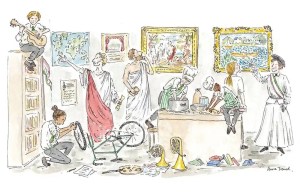Thirty years on from the fall of the Berlin Wall, socialism is back in fashion. The anniversary is a good occasion to reflect on some of the lessons that we have collectively un-learned, or perhaps never learned properly in the first place from the fall of Communism.
The division of Germany into a broadly capitalist West, and a broadly socialist East, represented a natural experiment, and did so in two ways.
It was, first of all, a gigantic economic experiment about the viability of socialism, and it produced conclusive results. Around the time of Reunification, West Germany’s GDP per capita was about three times that of East Germany’s. There was also around a three-year-gap in average life expectancy.
But it was also a gigantic political experiment. Around the time the German Democratic Republic was founded, Western intellectuals were falling out of love with the Soviet Union, which many had eulogized in the 1930s. But they could not bring themselves to give up on socialism entirely, so they had to convince themselves that Soviet socialism was just an atypical example.
They did so by blaming the Soviet Union’s totalitarian character on Russia’s backwardness. Democratic socialism, they argued, could not be built in a country of illiterate peasants. It requires an advanced economy, and an educated urban proletariat with experience in democratic self-management.
It is hard to think of a better test case for this assertion than East Germany. Underneath all the rubble of wartime destruction, the future GDR still had the foundations of a fully industrialized economy. It also had a highly educated and organized working class. Germany had already achieved a high adult literacy rate in the mid-19th century, and before their suppression by the Nazi regime, there had been hundreds of independent working-class associations.
It made little difference in the end. The GDR was not a carbon copy of the Soviet Union – it avoided the worst excesses – but it was still a notorious police state, hierarchical, stratified and technocratic to the core. It was a million miles away from the ‘workers’ democracy’ that was originally promised.
Today’s trendy millennial socialists would dispute that any of this matters. The Eastern Bloc, they argue, adopted a particular kind of socialism, authoritarian and top-down, which was itself removed from the original vision of Marx and Engels. They believe the right lesson from the Eastern Bloc is not to give up on socialism, but to go back to that original vision.
But as I show in my book Socialism: The Failed Idea That Never Dies, this is a completely ahistorical misinterpretation of the experience of real existing socialism. Socialists never started out with the intention of building totalitarian societies, but it still always turns out that way.
A few months before he came to power, Lenin outlined his ideas on what the future socialist society should look like, in The State and Revolution. The type of society that Lenin describes has almost nothing in common with the Soviet Union as it actually turned out. The State And Revolution does not at all read like an outline of a totalitarian society. Lenin does not describe a society run by an all-powerful, all-pervasive bureaucracy. He describes a society which more or less runs itself, like a very large working men’s club. It is not that Lenin simply omits the oppressive and technocratic features of the future world he has in mind. No: he specifically explains why society will not have, nor need such features.
In power, the Bolsheviks then learned the hard way that you cannot simply abolish markets, and hope that a society will somehow spontaneously organize itself without them.
Decades later, the leaders of East Germany’s Socialist Unity Party (SED) learned a similar lesson. In particular, the construction of the Berlin Wall was not an act of sadism. It was a desperate measure, to which they resorted after losing about one sixth of their population, and after less extreme measures had failed. Political repression and economic failure are in the DNA of socialism. They are features, not bugs.
This article was originally published on The Spectator’s UK website.



















